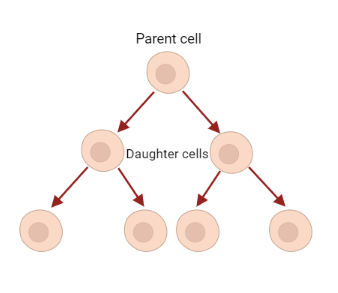by Dalia Fleifel
Cell division: Why and how?
The human body is estimated to be made up of ~37 trillion cells. A mind-blowing number, right? Now imagine how this huge number of cells is maintained to perform bodily functions. Let’s think about your skin cells. Whenever you cut your skin, your cells on either side of the cut must quickly “divide” to heal the wound. Cell division is defined as the fundamental process of life whereby cells multiply to make new cells in order to replace dead ones, repair damaged tissues, and help your body grow everyday (Image 1). Scientists have recently discovered that our bodies produce 3.8 million new cells every second! Each cell must divide accurately to give rise to two identical new cells that function properly. The original parent cells must first copy their DNA (genetic material of the cell) exactly so that it is equally distributed to each new daughter cell. This process of DNA copying is termed: DNA replication.

DNA replication in a nutshell
The DNA is made up of two strands that run together as a double helix. In order for DNA replication to start, this double helix is unwound by helicases, special enzymes that open up the DNA. This process of unwinding is not as easy as it looks. Imagine if you could take one cell, extract, uncoil, and stretch its DNA end-to-end, you will end up with an approximately 6 footlong thread of DNA. This super long DNA is tightly condensed and packaged to fit in a cell’s nucleus which is ~10 um in diameter. Unwinding this whole tightly packed DNA is definitely challenging. Thus, enzymes termed topoisomerases ensure that the unwound DNA does not get tangled during this process. After unwinding, enzymes called DNA polymerases progress along the DNA strand, read its sequence, and synthesize new DNA strands by adding nucleotides – the building blocks of DNA strands. Lastly, replication is terminated and both strands of the double helix are now duplicated (Image 2).

A balance between accuracy, efficiency, and timing of DNA replication
Accuracy during DNA synthesis is essential to ensure that new cells are functional and healthy. Polymerases are characterized by high fidelity as well as accurate proofreading ability by which they can correct mistakes as they are made. Moreover, polymerases are backed up with repair mechanisms that can fix their mistakes later. To achieve this high level of accuracy, polymerases must progress slowly at 500 to 5,000 nucleotides per minute. However, if replication only starts at one site along a DNA strand, it would take about a month to replicate a whole chromosome of DNA!
Cells have found smart ways to maintain accuracy while achieving maximal efficiency during replication. Unlike prokaryotes, DNA replication in humans starts at multiple sites where multiple helicases bind to long stretches of DNA to be able to unwind the DNA at multiple sites simultaneously. How could cells then make sure that sites that have been replicated once are not replicated twice, or even more?
Multiple control mechanisms ensure specific timing of DNA replication so that the whole genome is precisely duplicated only once. Before discussing these mechanisms, it is worth mentioning that each cell goes through a sequential one-way cycle of growth and preparation (in G1 phase), DNA replication (in S phase), more growth (in G2 phase) before dividing (in M phase). Cells load the unwinding helicases during G1 phase and prevent these helicases from opening up the DNA double helix until cells enter the S phase. Once cells enter the S phase, these helicases are prevented from loading onto DNA again to prevent DNA regions that have already replicated from re-replication (Image 3).

Next time you accidentally cut your skin, allow yourself some time to think of all the amazing processes taking place in each skin cell that surround your wound and allow it to heal!
